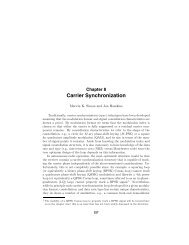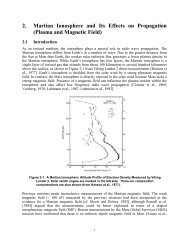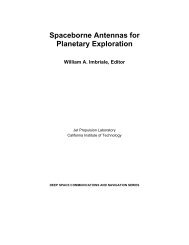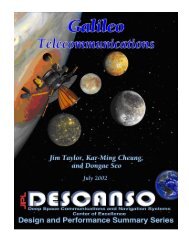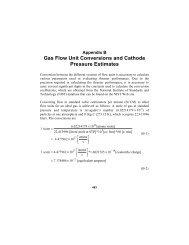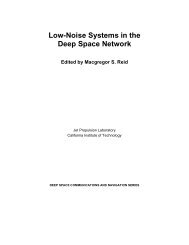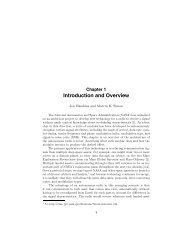Propagation Effects Handbook for Satellite Systems - DESCANSO ...
Propagation Effects Handbook for Satellite Systems - DESCANSO ...
Propagation Effects Handbook for Satellite Systems - DESCANSO ...
Create successful ePaper yourself
Turn your PDF publications into a flip-book with our unique Google optimized e-Paper software.
6.6.4.3 Refractive <strong>Effects</strong>. Variations in the radio refractivity<br />
(dielectric constant of tropospheric layers) can cause rotation of<br />
the polarization plane of the rays refracting through the layers.<br />
This condition will occur <strong>for</strong> layers which are not perpendicular to<br />
the vertical plane containing the transmitter and receiver as<br />
described by LeFrancois, et al (1973).<br />
6.6.5 Prediction of Depolarization Statistics<br />
This section presents a summary of the procedure <strong>for</strong> developing<br />
a prediction of depolarization statistics, in the <strong>for</strong>m of the<br />
cumulative distribution of XPD, <strong>for</strong> rain and ice-particle induced<br />
depolarization on a slant path. Figure 6.6-9 shows the methodology<br />
<strong>for</strong> developing the statistics. The XPD prediction requires the<br />
cumulative distribution of rain attenuation, either as measured or<br />
calculated from one of the methods described in Section 6.3.<br />
The coefficients ~ and ~ are determined at each percent p from<br />
the CCIR procedure, Eq. ‘S 6.6-2 and 6.6-3, <strong>for</strong> the given frequency?<br />
elevation angle, and polarization tilt angle (STEP 1). The rain<br />
induced XPD is then determined from the coefficients and from the<br />
rain attenuation distribution by Eq. 6.6-1 (STEP 2). The<br />
contribution from ice particles is determined from the CCIR<br />
relationship~ Eq. 6.6-6 (STEP 3).<br />
The procedure<br />
is valid in the frquency range 8 S f S 35 GHz.<br />
Outside of this frequency range, attenuation statistics are not<br />
useful in predicting XPD statistics. For frequencies below 8 GHz,<br />
relationships between XPD, point rain rate, and effective path<br />
length have been employed (see Oguchi-1977~ Kobayashi-1977)”<br />
Long term XPD statistics obtained at one frequency and<br />
polarization tilt angle can be scaled (STEP 4) to another frequency<br />
and polarization tilt angle using the semi -empirical relation (CCIR<br />
Rpt . 564-3, 1986b)/<br />
6-122<br />
.





